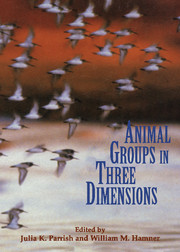Book contents
- Frontmatter
- Contents
- List of contributors
- Acknowledgments
- 1 Introduction – From individuals to aggregations: Unifying properties, global framework, and the holy grails of congregation
- Part one Imaging and measurement
- 2 Methods for three-dimensional sensing of animals
- 3 Analytical and digital photogrammetry
- 4 Acoustic visualization of three-dimensional animal aggregations in the ocean
- 5 Three-dimensional structure and dynamics of bird flocks
- 6 Three-dimensional measurements of swarming mosquitoes: A probabilistic model, measuring system, and example results
- Part two Analysis
- Part three Behavioral ecology and evolution
- Part four Models
- References
- Subject index
- Taxonomic index
6 - Three-dimensional measurements of swarming mosquitoes: A probabilistic model, measuring system, and example results
from Part one - Imaging and measurement
Published online by Cambridge University Press: 01 June 2010
- Frontmatter
- Contents
- List of contributors
- Acknowledgments
- 1 Introduction – From individuals to aggregations: Unifying properties, global framework, and the holy grails of congregation
- Part one Imaging and measurement
- 2 Methods for three-dimensional sensing of animals
- 3 Analytical and digital photogrammetry
- 4 Acoustic visualization of three-dimensional animal aggregations in the ocean
- 5 Three-dimensional structure and dynamics of bird flocks
- 6 Three-dimensional measurements of swarming mosquitoes: A probabilistic model, measuring system, and example results
- Part two Analysis
- Part three Behavioral ecology and evolution
- Part four Models
- References
- Subject index
- Taxonomic index
Summary
Introduction
Aggregations in flight such as mating swarms and group migration are widespread phenomena in the insects. However, due to the difficulties of three-dimensional measurement, many questions about insect aggregation, such as the process of group formation, identification of spatial structure within a group, or aspects of individual behavior such as spacing or mutual interference, remain unanswered. Using instruments available at the time, various methods have been developed for three-dimensional measurements of animal aggregations (for insect swarms: Okubo et al. 1981, Shinn & Long 1986; for fish schools: Cullen et al. 1965, Pitcher 1973, 1975; for bird flocks: Gould & Heppner 1974, Major & Dill 1978). In our methods, still or video cameras are used to record the positions of objects simultaneously from different perspectives. The principles of stereoscopy are then used to reconstruct the full three-dimensional positions of the objects based on sets of two-dimensional images.
In conventional stereoscopic methods, there are two problems which make three-dimensional measurements difficult. One is the camera calibration problem: precise adjustment of the cameras or other apparatus is essential for minimizing distortion in the images. The other is the correspondence or matching problem: matching the points in each image that correspond to the same object is difficult. Manual matching is an exhausting and unreliable process. Automatic matching is preferable, but so far there have been few algorithms or theories for such methods. Moreover, even if matching is done automatically, there are no effective methods of ensuring accuracy.
Information
- Type
- Chapter
- Information
- Animal Groups in Three DimensionsHow Species Aggregate, pp. 90 - 104Publisher: Cambridge University PressPrint publication year: 1997
Accessibility standard: Unknown
- 4
- Cited by
